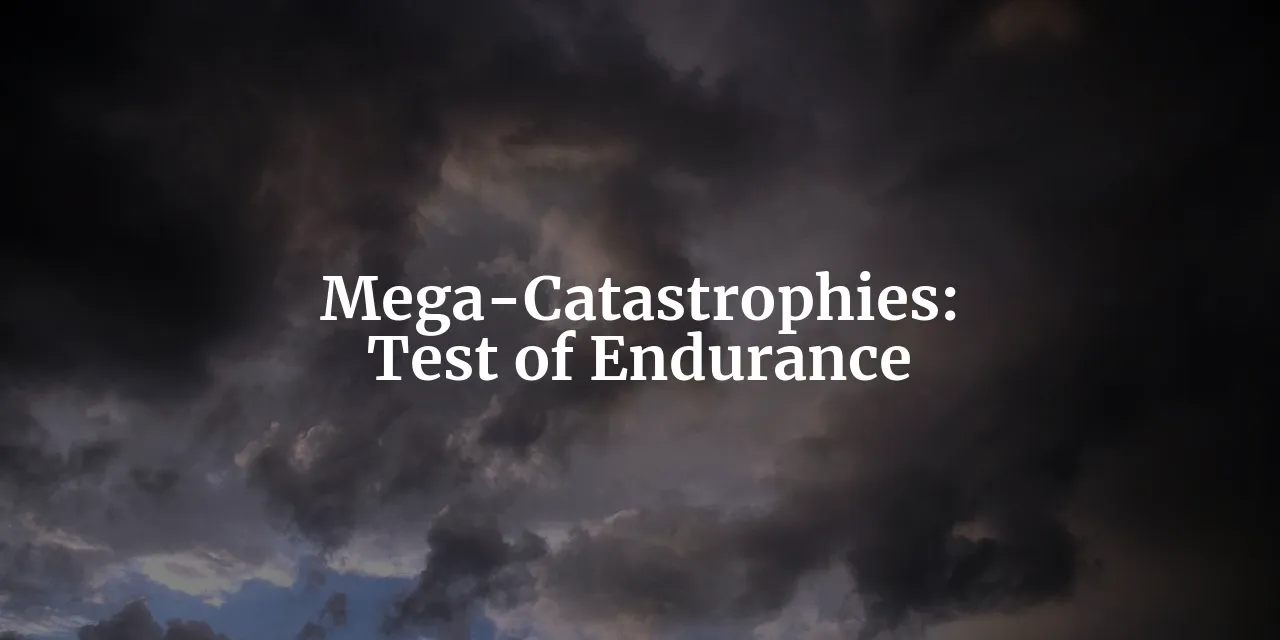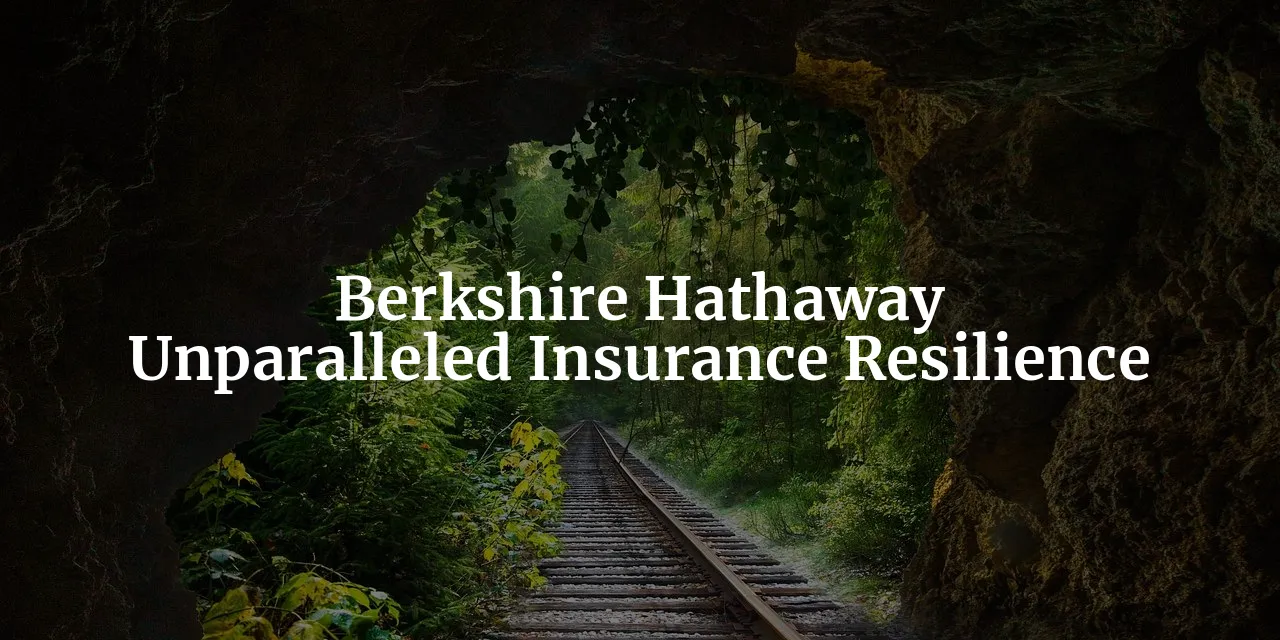Tags: Risk
This fanpage is not officially affiliated with Berkshire Hathaway: Disclaimer
Discover how Berkshire Hathaway, under the leadership of Warren Buffett and Ajit Jain, has crafted unparalleled insurance resilience to navigate mega-catastrophes. From conservative risk management to strategic use of technology and data, this article delves into the company's fortitude in the face of evolving global risks, inspiring a proactive and adaptive approach to the challenges of the future. As shareholders of Berkshire Hathaway, explore the unique position of the company in the insurance industry and its readiness to tackle the challenges of the 21st century.

Introduction
Berkshire Hathaway, under the stewardship of Warren Buffett and the strategic acumen of Ajit Jain, has sculpted a colossal business empire with its roots deeply entrenched in the insurance industry. This conglomerate, known for its diversified holdings, stands particularly tall in the realm of insurance, showcasing an unparalleled ability to withstand the financial storms brought about by mega-catastrophes. With a unique business model that emphasizes conservative risk management, Berkshire Hathaway's insurance operations, including giants like Geico and General Re, have been designed to not just survive but thrive amidst the industry's most challenging times. The concept of insurance float, a critical component of Berkshire's financial health, further bolsters this resilience, providing a substantial safety net that most competitors lack. As climate-related disasters become increasingly frequent and severe, impacting the insurance landscape dramatically, this article aims to delve into how Berkshire Hathaway's insurance operations are meticulously crafted to navigate through these tumultuous times. Through a historical, political, and economic lens, we will explore the foundation of Berkshire Hathaway's insurance resilience, setting the stage for a comprehensive understanding of its unmatched fortitude in the face of mega-catastrophes.
The Foundation of Resilience
At the heart of Berkshire Hathaway's insurance resilience lies a business model that is anything but ordinary ↗. Warren Buffett himself has lauded the company's insurance operations for their success, attributing it to "terrific managers and hard-to-replicate business models" 1. This success is not by chance but by design, with a conservative approach to risk-taking that sets Berkshire apart from most large insurers. The historical acquisition of key insurance subsidiaries like GEICO, General Re, and National Indemnity Company has not only expanded Berkshire's insurance portfolio but also solidified its position in the market by diversifying risk and leveraging economies of scale 4.
Central to Berkshire's insurance strategy is Ajit Jain, Director & Vice Chairman-Insurance Operations at Berkshire Hathaway. Jain's philosophy is to insure risks that no one else has the desire or capital to take on, creating tens of billions of value for Berkshire shareholders in the process, especially in the reinsurance business 1. This approach, coupled with Berkshire's conservative stance on risk, has enabled the company to prepare for mega-catastrophes in a way that few others can match. For instance, Berkshire Hathaway has stated its capability to financially withstand a $400 billion mega-catastrophe, a testament to its robust financial health and strategic foresight 2.
The significance of insurance float cannot be overstated in this context ↗. As of September 2023, Berkshire's insurance float stood at about $167 billion, acting as a formidable safety net that provides the company with a significant advantage over its competitors 9. This float represents premiums collected before claims are paid out, allowing Berkshire to invest these funds for its benefit. The judicious management of this float, under the guidance of Buffett and Jain, has been instrumental in ensuring that Berkshire's insurance operations not only survive but also profit from the challenges posed by mega-catastrophes.
Furthermore, Berkshire's navigation through the regulatory environment showcases its strategic prudence. The company's insurance and reinsurance subsidiaries, operating under less stringent regulations compared to admitted insurers, enjoy considerable flexibility in premium rate setting and policy formulation 3. This regulatory agility, combined with high credit ratings for its major insurance subsidiaries ↗, fortifies Berkshire's market position, enabling it to undertake risks that others shy away from while maintaining business stability.
Investopedia offers a comprehensive overview of non-health insurance companies, categorizing them by market capitalization 6. This analysis, utilizing Q1/22 data, highlights Berkshire Hathaway's remarkable role and resilience within the insurance sector. It is important to acknowledge that the comparison may considerably skew in favor of Berkshire Hathaway due to the influential presence of its extensive equity portfolio:
| Company Name | Market Capitalization (Q1/22) |
|---|---|
| Berkshire Hathaway (U.S.) | $714 billion |
| Ping An Insurance (China) | $141 billion |
| AIA Group (Hong Kong) | $123 billion |
| China Life Insurance (China) | $106 billion |
| Allianz (Germany) | $89 billion |
| Cigna (US) | $76 billion |
| Zurich Insurance (Switzerland) | $67 billion |
| AXA (France) | $65 billion |
| Humana (U.S.) | $55 billion |
| Munich (Germany) | $39 billion |
The foundation of Berkshire Hathaway's insurance resilience is built on a strategic confluence of conservative risk management, astute leadership, regulatory navigation, and the effective use of insurance float. This foundation not only positions Berkshire to handle the financial repercussions of mega-catastrophes but also to capitalize on opportunities that such events may present, setting a benchmark in the insurance industry for others to aspire to.

Mega-Catastrophes: A Test of Endurance
In the insurance world, mega-catastrophes represent the ultimate test of an insurer's resilience and financial strength. These are events so devastating that they can reshape the landscape of the insurance industry, leading to significant financial implications for insurers. A mega-catastrophe could be a natural disaster, such as a hurricane or wildfire, causing widespread destruction. The financial toll from such events can be staggering, with insurers facing billions in claims payouts.
Historically, the insurance industry has weathered significant losses due to catastrophes. For instance, the hurricanes Harvey, Irma, and Maria, along with the California wildfires in 2017, led to a combined insurance underwriting loss of $3.24 billion before taxes for Berkshire Hathaway 2. This illustrates the scale of financial impact these events can have on insurers. Moreover, the U.S. insurance industry has suffered historic losses from wildfires over the last decade, with insured losses skyrocketing and nine of the ten costliest wildfires occurring in or after 2017 7.
Despite these challenges, Berkshire Hathaway stands out for its unparalleled resilience. The company claims it can financially withstand a $400 billion mega-catastrophe, a testament to its robust financial health and strategic risk management 2. This confidence is partly due to Berkshire's conservative approach to risk, preferring to avoid it more than most large insurers 1. Furthermore, the increasing frequency of billion-dollar insured catastrophe loss events, with 2023 setting a new record of 32 such events by the end of September, underscores the growing threat posed by climate change and the need for insurers to be prepared 8.
Climate change is reshaping the future of insurance risks and premiums, especially in disaster-prone areas. Nearly 39 million homes and commercial properties in the Lower 48 are at risk of insurance premiums spiking due to climate disasters 5. This evolving landscape requires insurers to adapt and innovate to manage these increasing risks effectively.
The strategic importance of reinsurance in spreading risk cannot be overstated ↗. Berkshire Hathaway's insurance model, which includes Geico auto insurer and General Re reinsurer, is uniquely suited to benefit from mega-catastrophes. The company's ability to spread risk across its vast insurance operations, combined with a conservative approach to risk-taking, positions it well to navigate the challenges posed by mega-catastrophes.
Ajit Jain: The Architect of Berkshire's Insurance Fortitude
At the heart of Berkshire Hathaway's insurance resilience is Ajit Jain, the architect of the company's insurance fortitude ↗. Jain manages the Berkshire Hathaway Reinsurance Group, taking on risks that others shy away from due to their magnitude or complexity 1. His contributions have been pivotal, creating tens of billions of value for Berkshire shareholders and solidifying the company's standing in the insurance industry.
Jain's innovative insurance products and strategies have allowed Berkshire to insure against giant or unusual risks, setting the company apart from its competitors 2. His philosophy on risk management aligns closely with Warren Buffett's conservative approach, focusing on avoiding risks that do not offer commensurate rewards 1. This cautious strategy has been instrumental in enabling Berkshire to absorb the financial impact of mega-catastrophes without derailing its growth and profitability.
Under Jain's leadership of insurance subsidiaries ↗, Berkshire Hathaway has navigated major insurance losses due to climate change, such as those from hurricanes and wildfires, with remarkable adeptness 5. His influence extends beyond financial management to shaping the corporate culture within Berkshire's insurance subsidiaries, fostering an environment of prudent risk assessment and innovative problem-solving.
While not all of Berkshire Hathaway's roughly 50,000 employees within its insurance subsidiaries are directly involved in managing mega-catastrophes, it is intriguing to note that Berkshire stands as one of the largest employers in the global insurance industry. A brief overview of employee distribution can be found in the 2022 annual report 3:
| Company | Number of Employees |
|---|---|
| GEICO | 38,285 |
| Berkshire Hathaway Reinsurance Group | 658 |
| General Re | 2,101 |
| Berkshire Hathaway Homestate Companies | 1,157 |
| Berkshire Hathaway Specialty | 1,427 |
| Berkshire Hathaway GUARD Insurance Companies | 1,082 |
| MedPro Group Inc. | 1,201 |
| MLMIC Insurance Companies | 247 |
| National Indemnity Primary Group | 1,263 |
| United States Liability Insurance Companies | 1,089 |
| Alleghany | 1,399 |
| Central States Indemnity | 21 |
| Total | 49,930 |
Looking ahead, Jain and his team face the challenge of adapting to the evolving global insurance dynamics, particularly in the context of climate change. The increasing frequency and severity of natural disasters require a forward-thinking approach to insurance underwriting and risk management. With Jain at the helm, Berkshire Hathaway is well-positioned to continue its legacy of insurance resilience, leveraging technology, data, and innovative strategies to mitigate risks and safeguard its financial health against the backdrop of a changing climate.
Ajit Jain's role in Berkshire Hathaway's insurance operations exemplifies the importance of visionary leadership in navigating the complex landscape of mega-catastrophes. His contributions have not only fortified Berkshire's insurance business but have also set a benchmark for the industry in managing and withstanding the financial shocks of catastrophic events.
The Role of Technology and Data in Mitigating Risks
In the intricate world of insurance, Berkshire Hathaway stands as a colossus, not just for its sheer size but for its strategic utilization of technology and data in navigating the labyrinth of risks it insures against. The conglomerate, under the stewardship of Ajit Jain, has transformed the way risks are assessed, priced, and managed, leveraging the power of catastrophe modeling and data analytics 7. This is particularly evident in their approach to natural disasters, such as wildfires, which have become more frequent and severe due to climate change.
Catastrophe modeling has become a cornerstone of many insurer's strategy including Berkshire Hathaway's to understand and price risks associated with natural disasters ↗. This involves using sophisticated software to simulate the financial impact of catastrophic events like hurricanes, earthquakes, and wildfires on their insurance portfolio 7. The investment in research and development in this area not only aids in accurate risk assessment but also in developing resilient insurance products that can withstand the financial strain of mega-catastrophes.
The adoption of technology has had a profound impact on insurance premiums and policy offerings, especially in regions prone to natural disasters. For instance, the surge in premiums in areas like California, Florida, and Louisiana, due to increased climate risks, underscores the importance of accurate risk pricing 5. Furthermore, regulatory changes, such as California's reversal of its prohibition on insurers using catastrophic risk models, highlight the growing recognition of technology's role in enhancing the industry's resilience 7.
Beyond risk assessment, technology also promises to revolutionize claims processing and fraud detection, making the insurance process more efficient and trustworthy. The potential for insurtech startups to disrupt the traditional insurance landscape presents both challenges and opportunities for established players like Berkshire. These startups, with their agile approaches to insurance, underscore the necessity for traditional insurers to continuously innovate and adapt to the evolving technological landscape.
Berkshire Hathaway's Future in a Changing Climate
The specter of climate change looms large over the insurance industry, with its capacity to amplify risks and reshape the global insurance market. For Berkshire Hathaway, the implications are manifold, affecting not just the nature of the risks insured but also the strategic direction of its vast insurance portfolio. The increasing frequency and severity of climate disasters have led to a spike in insurance premiums and a reevaluation of market presence, particularly in high-risk areas 5.
Berkshire Hathaway's strategic position, fortified by a current float of about $167 billion, provides a unique vantage point from which to tackle climate-induced financial risks. This considerable financial buffer allows Berkshire to absorb shocks that would otherwise destabilize less capitalized insurers. However, the changing climate necessitates a shift in strategy, potentially involving a diversification of the insurance portfolio to mitigate exposure to high-risk markets.
The role of government policies and insurance regulations, such as the Terrorism Risk Insurance Program, cannot be understated in shaping Berkshire's approach to managing climate risks 3. These policies provide a framework within which Berkshire operates, influencing decisions on coverage limits, premium rates, and market participation.
Berkshire Hathaway's commitment to sustainability and climate risk mitigation is evident in its insurance practices ↗, which are increasingly aligned with global efforts to combat climate change. The development of new insurance products and services tailored to emerging risks associated with climate change is indicative of Berkshire's proactive stance in navigating the challenges posed by a changing climate.
The importance of global collaboration and information sharing among insurers is paramount in understanding and mitigating climate risks. As the industry grapples with the uncertainties presented by climate change, Berkshire Hathaway's resilience, underpinned by its strategic use of technology and data, positions it well to navigate the tumultuous waters ahead.
Berkshire Hathaway's future, in the face of mega-catastrophes and a changing climate, hinges on its ability to innovate, adapt, and collaborate. The company's strategic investments in technology and data analytics, coupled with its commitment to sustainability, underscore its resilience and readiness to tackle the challenges of the 21st century.

Conclusion
Berkshire Hathaway's insurance resilience is a testament to its unique position in the industry, underpinned by conservative risk management, strategic leadership, and technological innovation. The company's foundation of resilience, built on a confluence of factors such as Ajit Jain's leadership, the strategic acquisition of key insurance subsidiaries, and the effective use of insurance float, sets it apart as a beacon of stability amidst the tumultuous landscape of mega-catastrophes.
The ongoing challenges posed by mega-catastrophes and climate change underscore the importance of forward-thinking strategies in the insurance industry. Berkshire Hathaway's ability to withstand the financial impact of catastrophic events and adapt to the evolving global risks positions it as a trailblazer in shaping the future of insurance. The company's commitment to sustainability and climate risk mitigation, coupled with its strategic investments in technology and data analytics, exemplifies its readiness to tackle the challenges of the 21st century.
As shareholders of Berkshire Hathaway, it is crucial to recognize the broader implications of insurance resilience in the face of natural disasters and climate change. The company's unwavering fortitude not only safeguards its financial health but also serves as a beacon of stability for the broader insurance industry. In the words of Warren Buffett, "Risk comes from not knowing what you're doing", encapsulating Berkshire Hathaway's philosophy on insurance and risk management.
In the face of evolving global risks, Berkshire Hathaway's resilience serves as a guiding light for the industry, inspiring a proactive and adaptive approach to navigating the challenges of the future.
References
-
Berkshire Hathaway Annual Report 2016 - Chairman's Letter - berkshirehathaway.com ↩↩↩↩↩
-
Buffett says Berkshire can handle $400 billion mega-catastrophe - www.reuters.com ↩↩↩↩
-
Berkshire Hathaway Annual Report 2022 - Insurance and Reinsurance Businesses - berkshirehathaway.com ↩↩↩
-
Berkshire Hathaway - Wikipedia - en.wikipedia.org ↩
-
Insurance premiums could surge in these American cities because of climate disasters, new data shows | CNN Business - edition.cnn.com ↩↩↩↩
-
Top Insurance Companies - www.investopedia.com ↩
-
Insurers race to study wildfires as losses mount - www.eenews.net ↩↩↩↩
-
2023 sets new record for billion dollar insured catastrophe loss events: Aon - Artemis.bm - www.artemis.bm ↩
-
Berkshire Hathaway Q3 earnings rise 41% Y/Y, cash holdings jump to $157B (NYSE:BRK.B) - seekingalpha.com ↩











